Assessment and Analysis of QuikSCAT Vector Wind Products for the Gulf of Mexico: A Long-Term and Hurricane Analysis
Abstract
:1. Introduction
2. Data and Methods
2. Results and discussion
2.1. Level 2B Swath data
2.2. Level 3 Gridded data
2.3. Hurricane Analysis
3. Conclusions
Acknowledgments
References and Notes
- Adams, I.S.; Jones, W.L.; Vasudevan, S.; Soisuvarn, S. Hurricane Wind Retrievals Using the SeaWinds Scatterometer on QuikSCAT. OCEANS Proceedings of MTS/IEEE 2005, 3, 2148–2150. [Google Scholar]
- Atlas, R.; Bloom, S.C.; Homan, R.N.; Brin, E.; Ardizzone, J.; Terry, J.; Bungato, D.; Jusem, J.C. Geophysical Validation of NSCAT Winds Using Atmosheric Data and Analyses. Journal of Geophysical Research 1999, 104(C5), 11405–11424. [Google Scholar]
- Brennan, M.J.; Knabb, R.D. Operational Evaluation of QuikSCAT Ocean Surface Vector Winds in Tropical Cyclones at the Tropical Prediction Center/National Hurricane Center, 10.5.
- Callahan, P.S. QuikSCAT Science Data Product User's Manual, Overview and Geophysical Data Products. V3.0. D-18053-RevA, JPL. 2006. ftp://podaac.jpl.nasa.gov/pub/ocean_wind/quikscat/doc/QSUG_v3.pdf.
- Chao, Y.; Li, Z.; Kindle, J.C.; Paduan, J.D.; Chavez, F.P. A High-Resolution Surface Vector Wind Product for Coastal Oceans: Blending Satellite Scatterometer Measurements with Regional Mesoscale Atmospheric Model Simulations. Geophysical Research Letters 2003, 30(1), 13.1–13.4. [Google Scholar]
- Chelton, D.B.; Schlax, M.G.; Freilich, M.H.; Milliff, R.F. Satellite Measurements Reveal Persistent Small-Scale Features in Ocean Winds. Science 2004, 303, 978–982. [Google Scholar]
- Chelton, D.B.; Freilich, M.H.; Sienkiewicz, J.M.; Von Ahn, J.M. On the Use of QuikSCAT Scatterometer Measurements of Surface Winds for Marine Weather Prediction. Monthly Weather Review 2006, 134, 2055–2070. [Google Scholar]
- Cione, J.J.; Uhlhorn, E.W. Sea Surface Temperature Variability in Hurricanes: Implications with Respect to Intensity Change. Monthly Weather Review 2003, 131, 1784–1796. [Google Scholar]
- Dunbar, R. S.; Perry, K.L. SeaWinds on QuikSCAT Level 3 Daily, Gridded Ocean Wind Vectors. JPL SeaWinds Project. 2001. Version 1.1, ftp://podaac.jpl.nasa.gov/pub/ocean_wind/quikscat/L3/doc/qscat_L3.pdf.
- Dunbar, R. S.; Hsiao, V.S.; Kim, Y.-J.; Pak, K.S.; Weiss, B.H.; Zhang, A. SeaWinds Algorithm Specifications. JPL D-21978. 2001. ftp://podaac.jpl.nasa.gov/ocean_wind/quikscat/doc/SWS_Algorithm_SpecsL1.pdf.
- Dunbar, R.S. Level 2B Data Software Interface Specification (SIS-2), SeaWinds Processing and Analysis Center, JPL. 2006. ftp://podaac.jpl.nasa.gov/pub/ocean_wind/quikscat/L2B/doc/L2B_SIS_200609.pdf.
- Ebuchi, N.; Graber, H.C.; Caruso, M.J. Evaluation of Wind Vectors Observed by QuikSCAT/SeaWinds Using Ocean Buoy Data. Journal of Atmospheric and Oceanic Technology 2002, 19, 2049–2061. [Google Scholar]
- Emanuel, K.A. Increasing Destructiveness of Tropical Cyclones over the Past 30 years. Nature 2005, 436, 686–688. [Google Scholar]
- Freilich, M.H.; Dunbar, R.S. The Accuracy of the NSCAT 1 Vector Winds: Comparisons with National Data Buoy Center Buoys. Journal of Geophysical Research 1999, 104(C5), 11231–11246. [Google Scholar]
- Freilich, M.H. SeaWinds Algorithm Theoretical Basis Document. NASA. ftp://podaac.jpl.nasa.gov/pub/ocean_wind/quikscat/doc/atbd-sws-01.pdf.
- Gilhousen, D.B. A field evaluation of NDBC moored buoy winds. Journal of Atmospheric and Oceanic Technology 1987, 4, 94–104. [Google Scholar]
- Hennon, C.C.; Long, D.G.; Wentz, F.J. Validation of QuikSCAT Wind Retrievals in Tropical Cyclone Environments, JP1.1. Joint Poster Session 1, Marine Meteorological Applications of Real and Synthetic Aperture Radar 2006. Joint between the 14th Conference on Interaction of the Sea and Atmosphere and 14th Conference on Satellite Meteorology and Oceanography. [Google Scholar]
- Hoffman, R.N.; Leidner, S.M. 2005. An introduction to the near-real-time QuikSCAT data. Weather and Forecasting 2005, 20, 476–493. [Google Scholar]
- Mears, C.; Smith, D.; Wentz, F. Detecting rain with QuikSCAT. Proceedings of the IEEE International Geoscience and Remote Sensing Symposium, Honolulu, Hawaii; 2002; 3, pp. 1235–1237. [Google Scholar]
- Pickett, M.H.; Tang, W.; Rosenfeld, L.K.; Wash, C.H. QuikSCAT Satellite Comparisons with Nearshore Buoy Wind Data off the U.S. West Coast. Journal of Atmospheric and Oceanic Technology 2003, 20, 1869–1878. [Google Scholar]
- Portabella, M.; Stoffelen, A. Rain detection and quality control of SeaWinds. Journal of Atmospheric and Oceanic Technology 2001, 18, 1171–1183. [Google Scholar]
- Portabella, M.; Stoffelen, A. A comparison of KNMI quality control and JPL rain flag for SeaWinds. Canadian Journal of Remote Sensing 2002, 28, 424–430. [Google Scholar]
- Ruti, P.M.; Marullo, S.; D’Ortenzio, S.; Tremant, M. Comparison of analyzed and measured wind speeds in the perspective of oceanic simulations over the Mediterranean basin: Analyses, QuikSCAT and buoy data. Journal of Marine Systems 2008, 70, 33–48. [Google Scholar]
- Shaffer, S.; Dunbar, R.S.; Hsiao, S.V.; Long, D.G. A median-filter-based ambiguity removal algorithm for NSCAT. IEEE Transactions on Geoscience and Remote Sensing 1991, 29, 167–174. [Google Scholar]
- Stiles, B.W. Special Wind Vector Data Product: Direction Interval Retrieval with Threshold Nudging (DIRTH), Product Description. Version 1.1. Jet Propulsion Laboratory. 1999. [Google Scholar]
- Stoffelen, A. Error modeling and calibration; towards the true surface wind speed. Journal of Geophysical Research 1998, 103(C4), 7755–7766. [Google Scholar]
- Stoffelen, A. A probabilistic approach for SeaWinds data assimilation. Quarterly Journal of Royal Meteorological Society 2004, 130, 127–152. [Google Scholar]
- Stone, G.W.; Walker, N.D.; Hsu, S.A.; Babin, A.; Liu, B.; Keim, B.D.; Teague, W.; Mitchell, D.; Leben, R. Hurricane Ivan's Impact Along The Northern Gulf of Mexico. EOS 2005, 86(48), 497–508. [Google Scholar]
- Tang, W.; Liu, W.T.; Stiles, B.W. Evaluation of High-Resolution Ocean Surface Vector Winds Measured by QuikSCAT Scatterometer in Coastal Regions. IEEE Transactions on Geoscience and Remote Sensing 2004, 42(8), 1762–1769. [Google Scholar]
- Wang, D.W.; Mitchell, D.A.; Teague, W.J.; Jarosz, E.; Hulbert, M.S. Extreme Waves Under Hurricane Ivan. Science 2005, 309, 896. [Google Scholar]
- Yueh, S.H.; Stiles, B.W.; Liu, W.T. QuikSCAT Wind Retrievals for Tropical Cyclones. IEEE Transactions on Geoscience and Remote Sensing 2003, 41(11), 2616–2627. [Google Scholar]
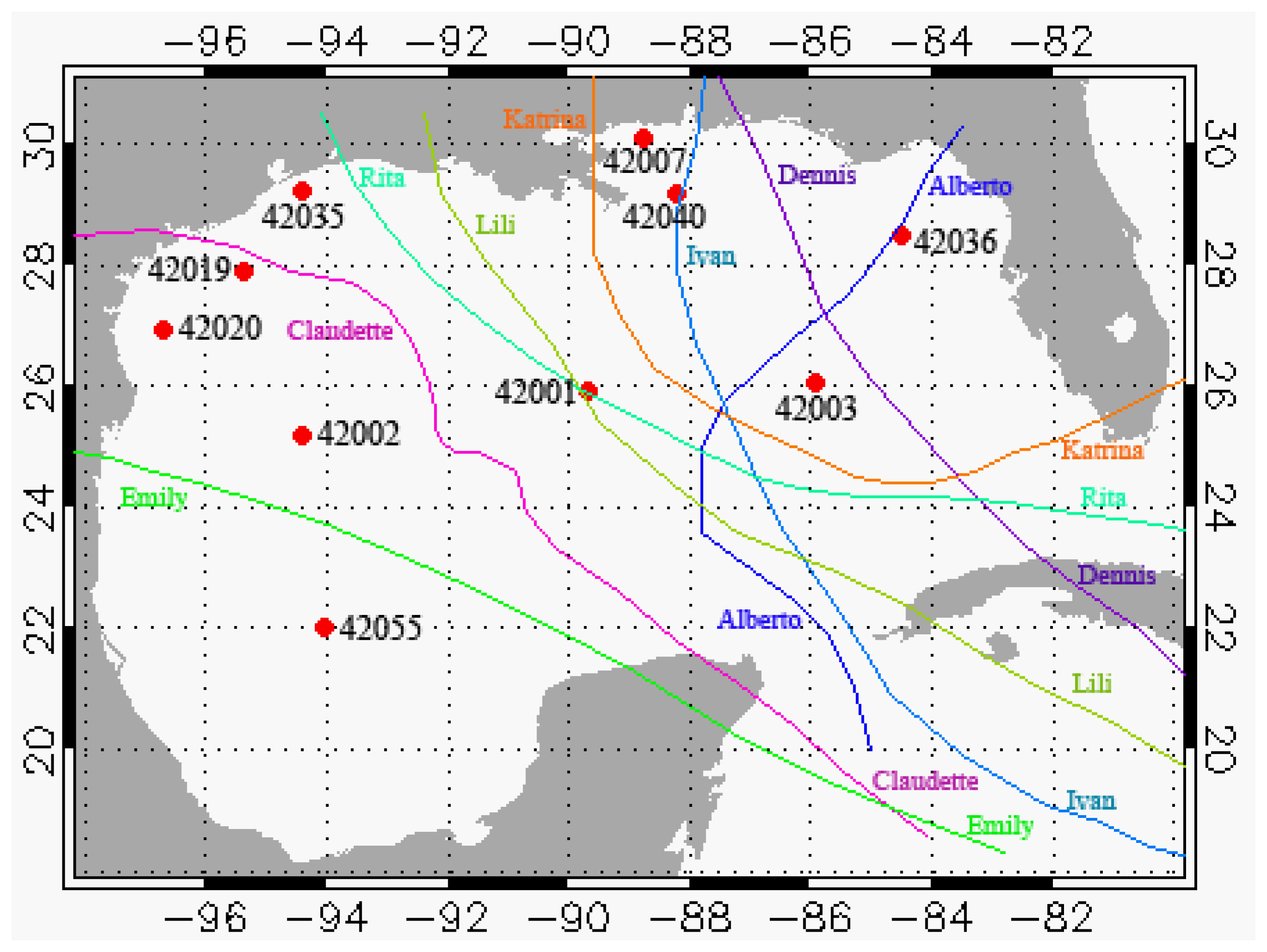
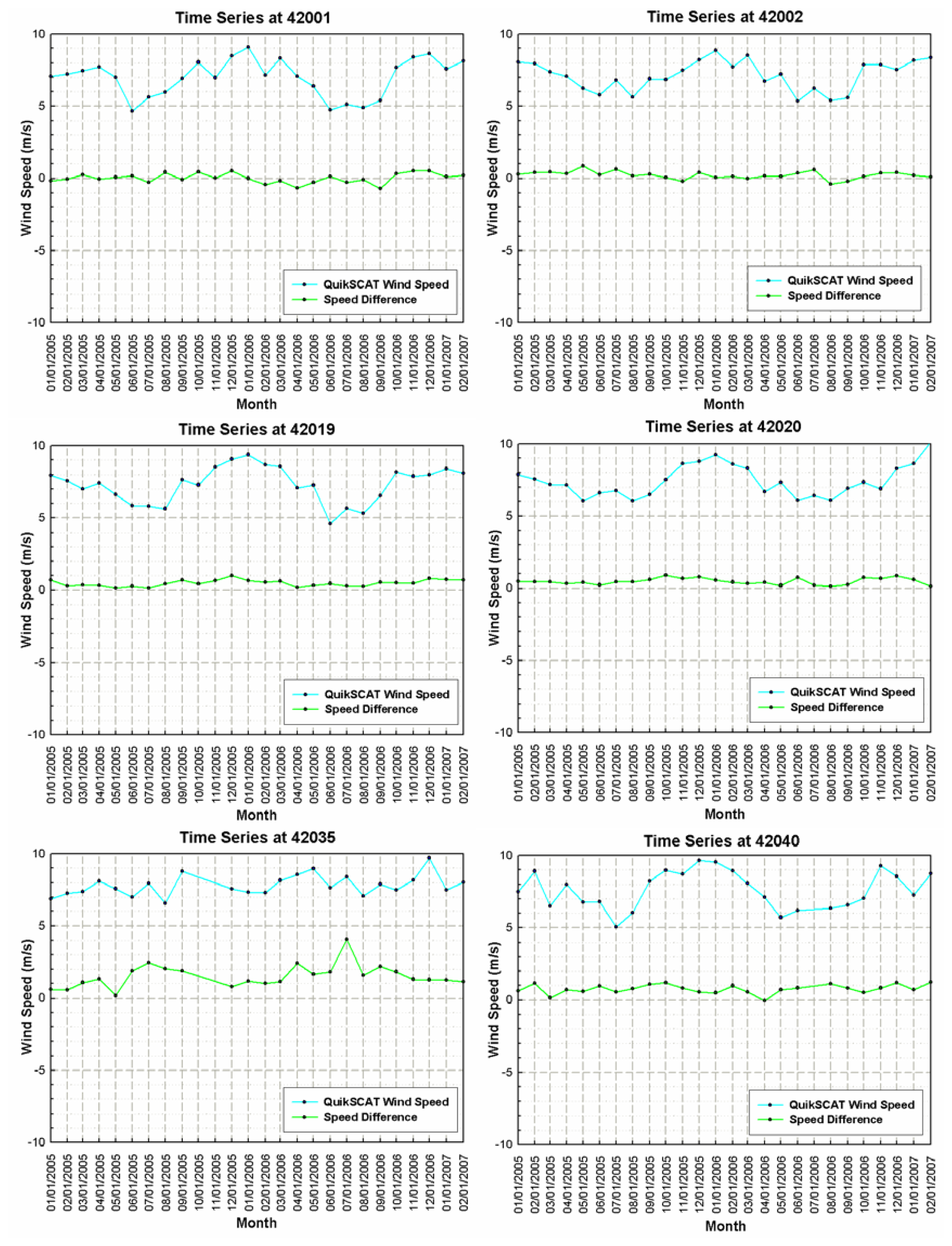
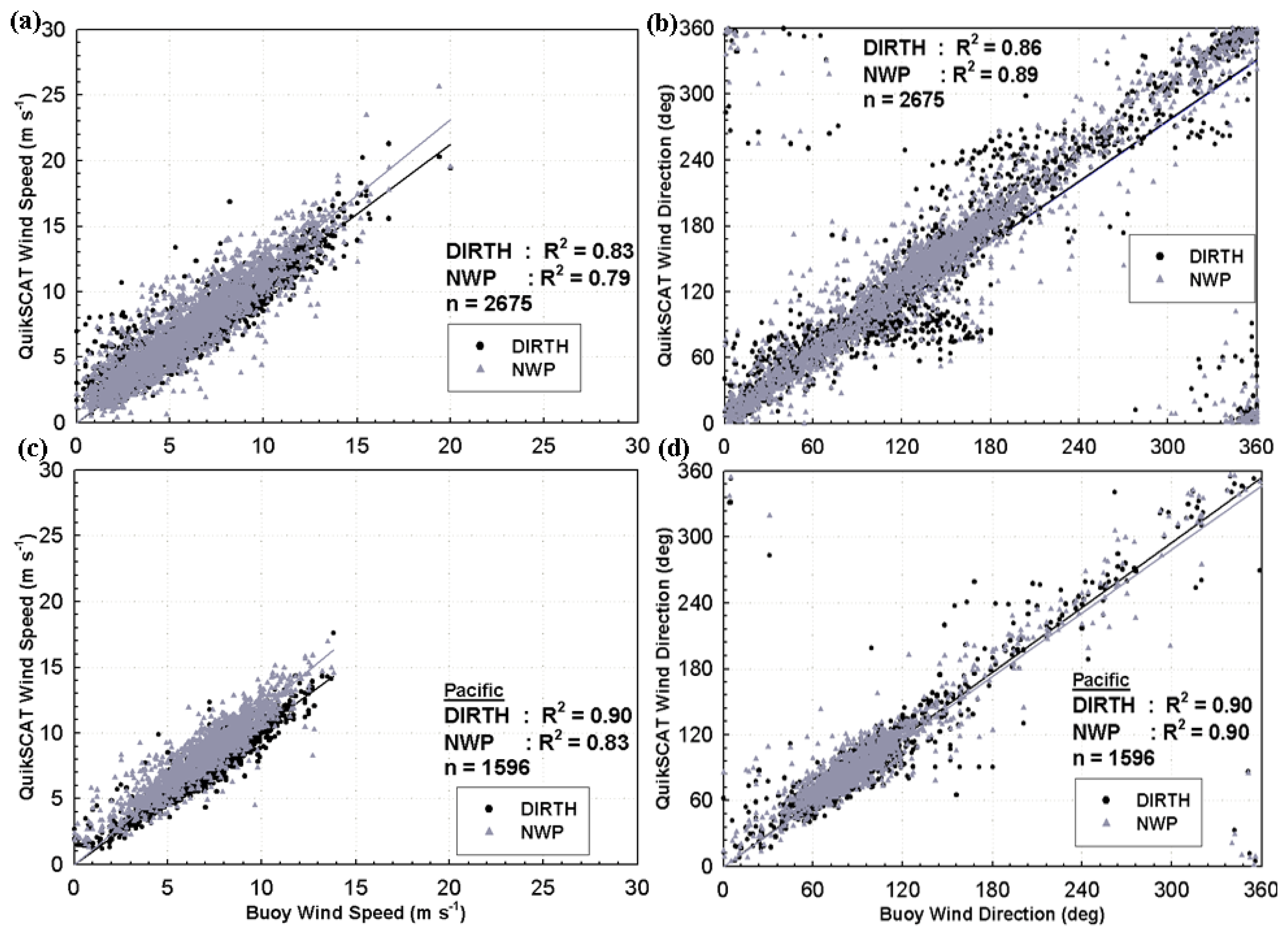
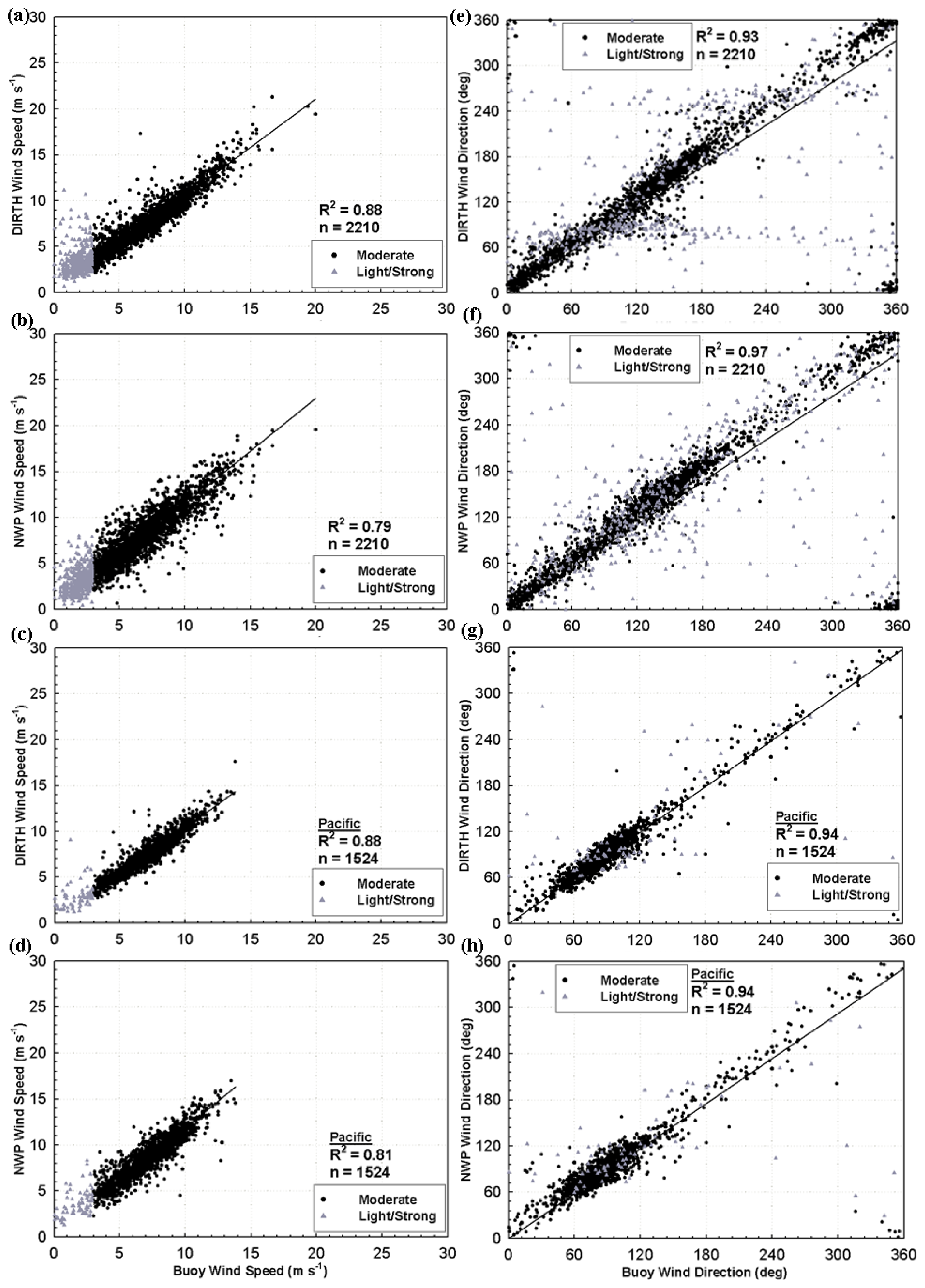
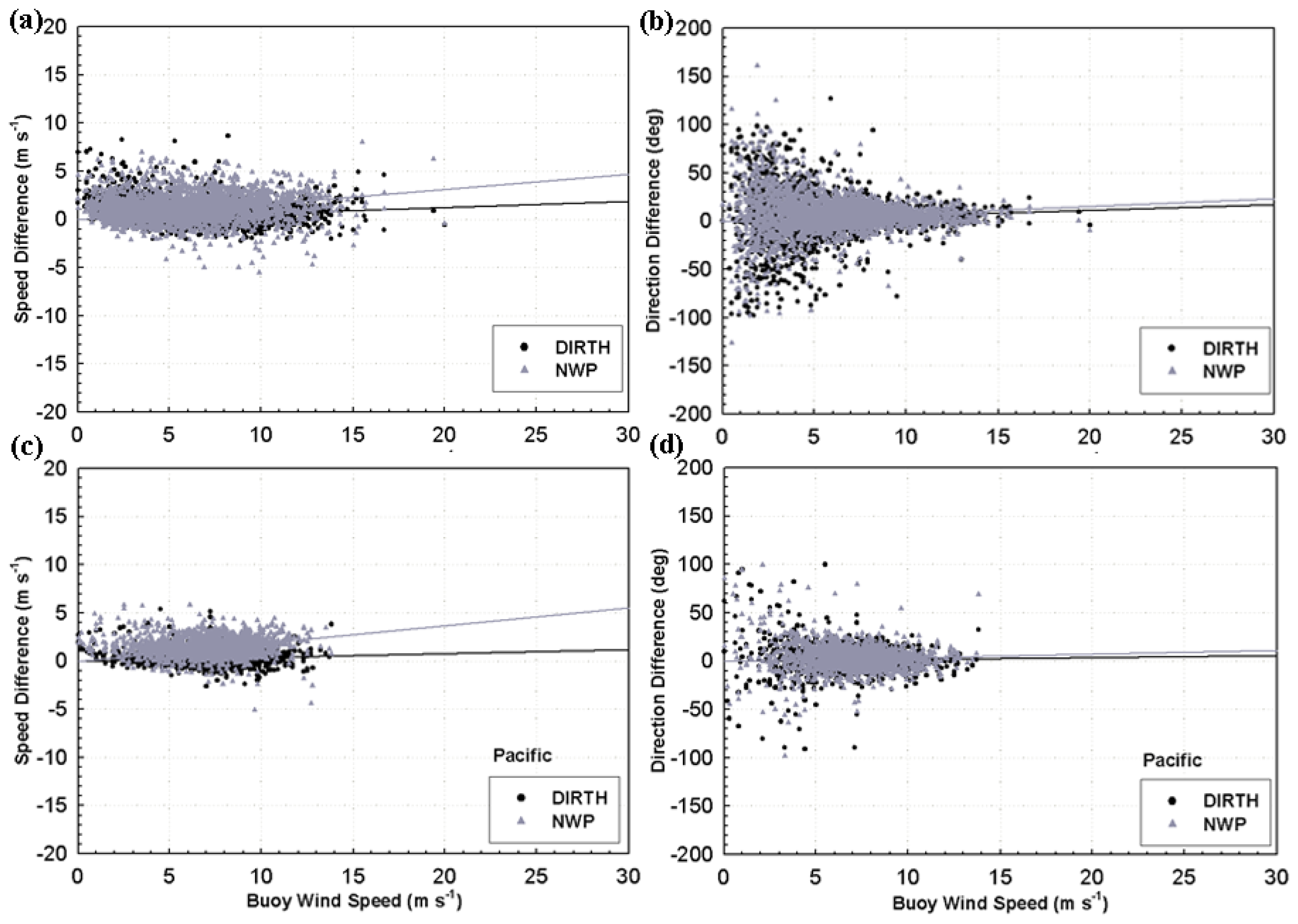
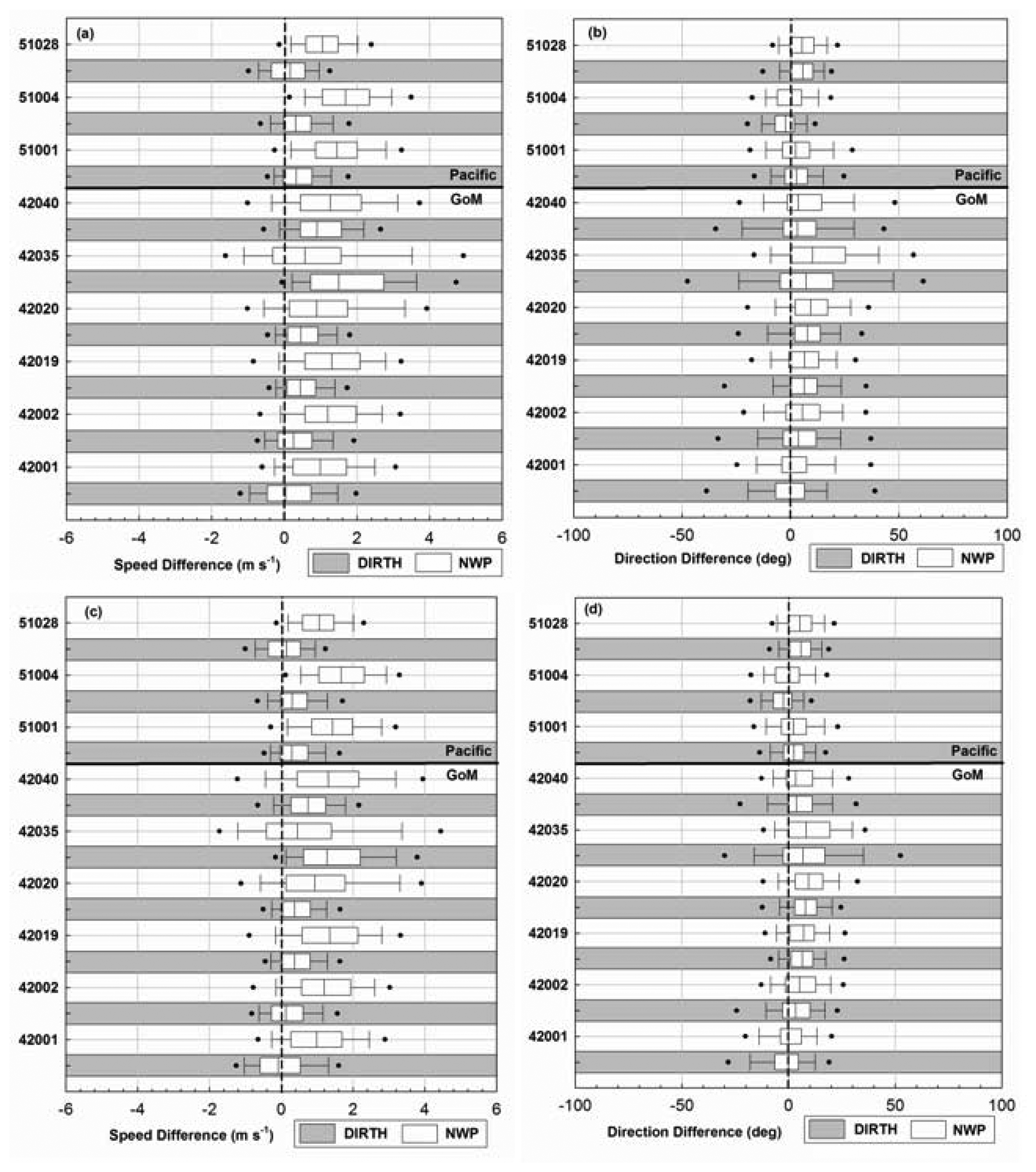
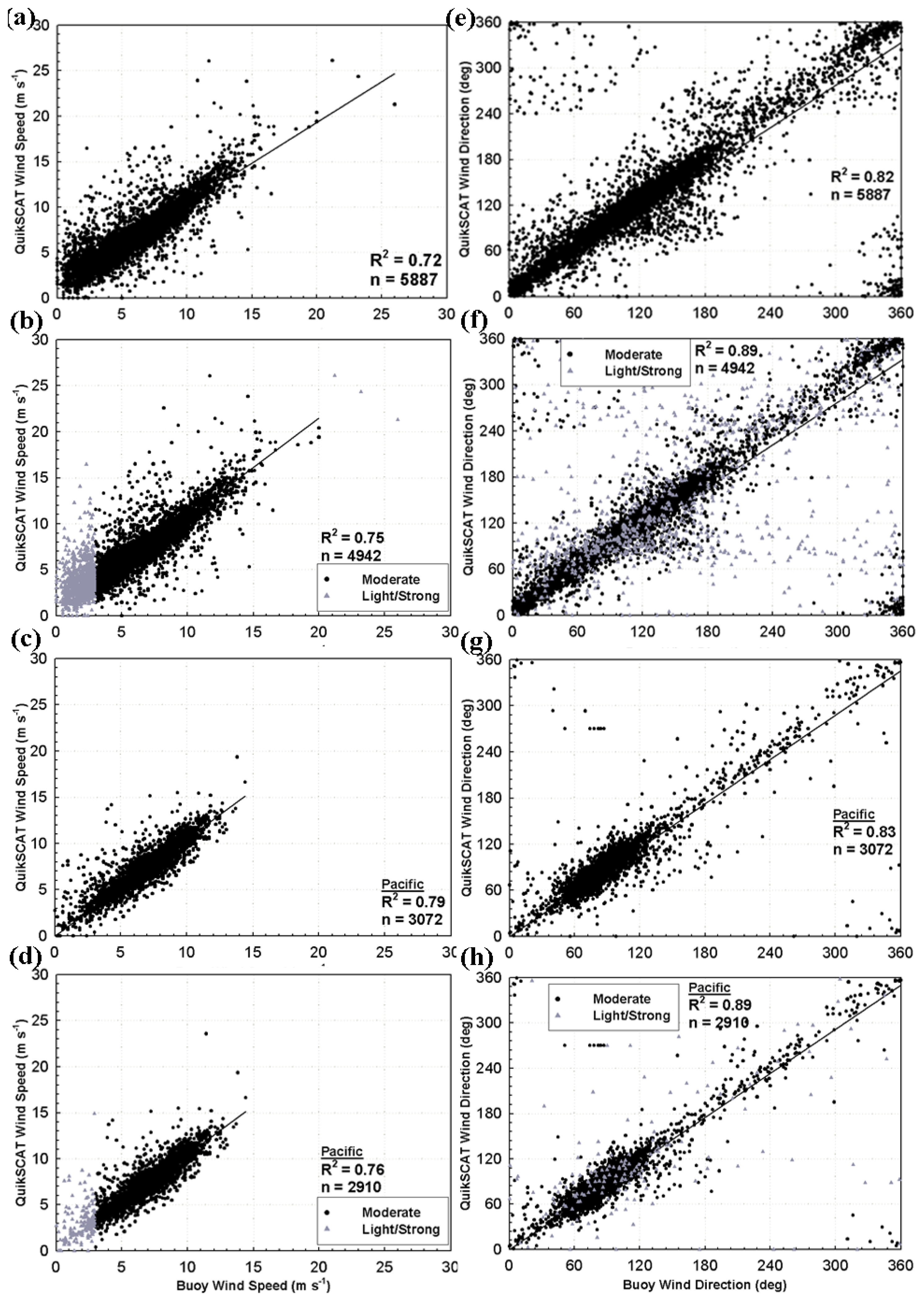
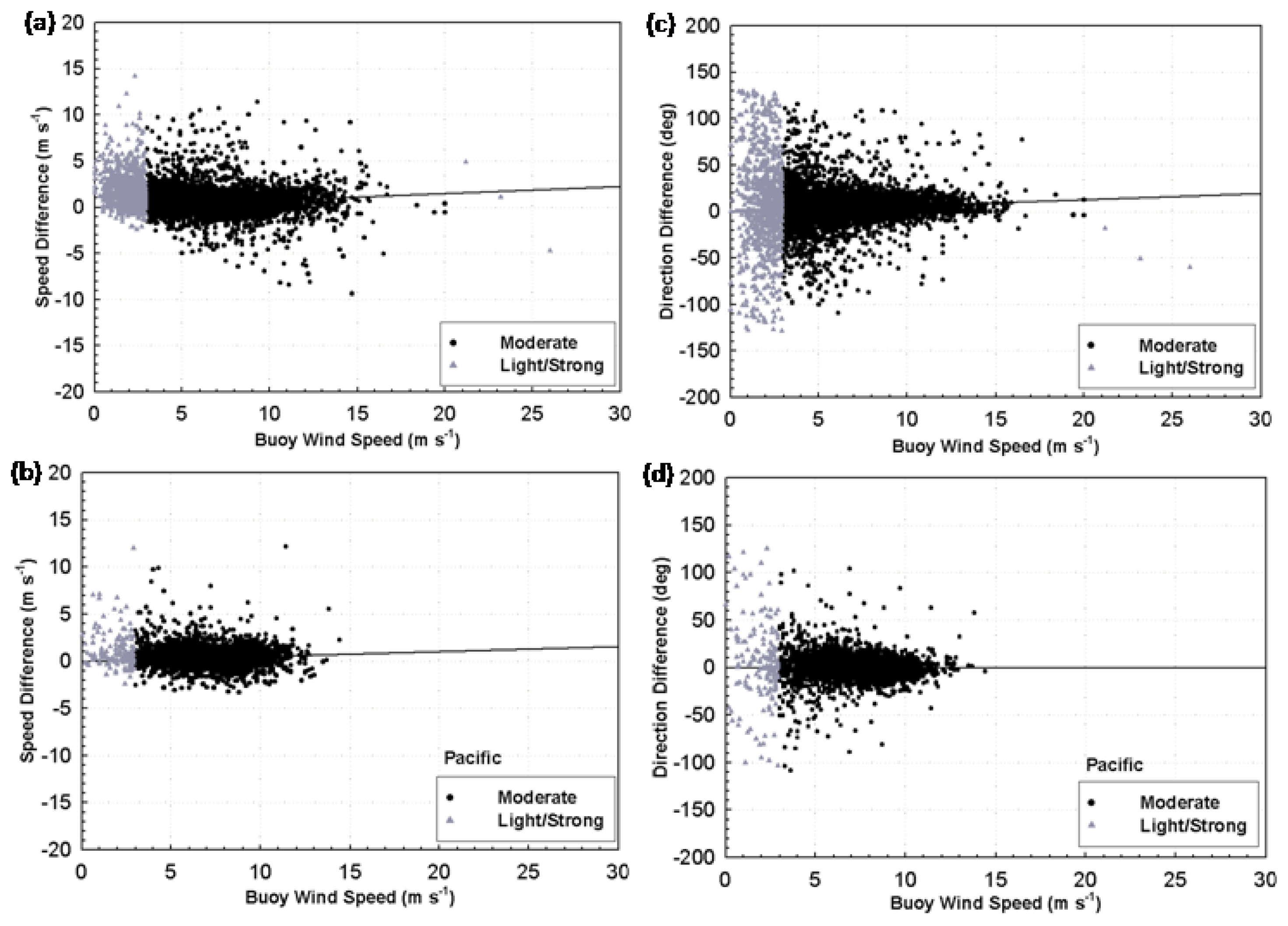
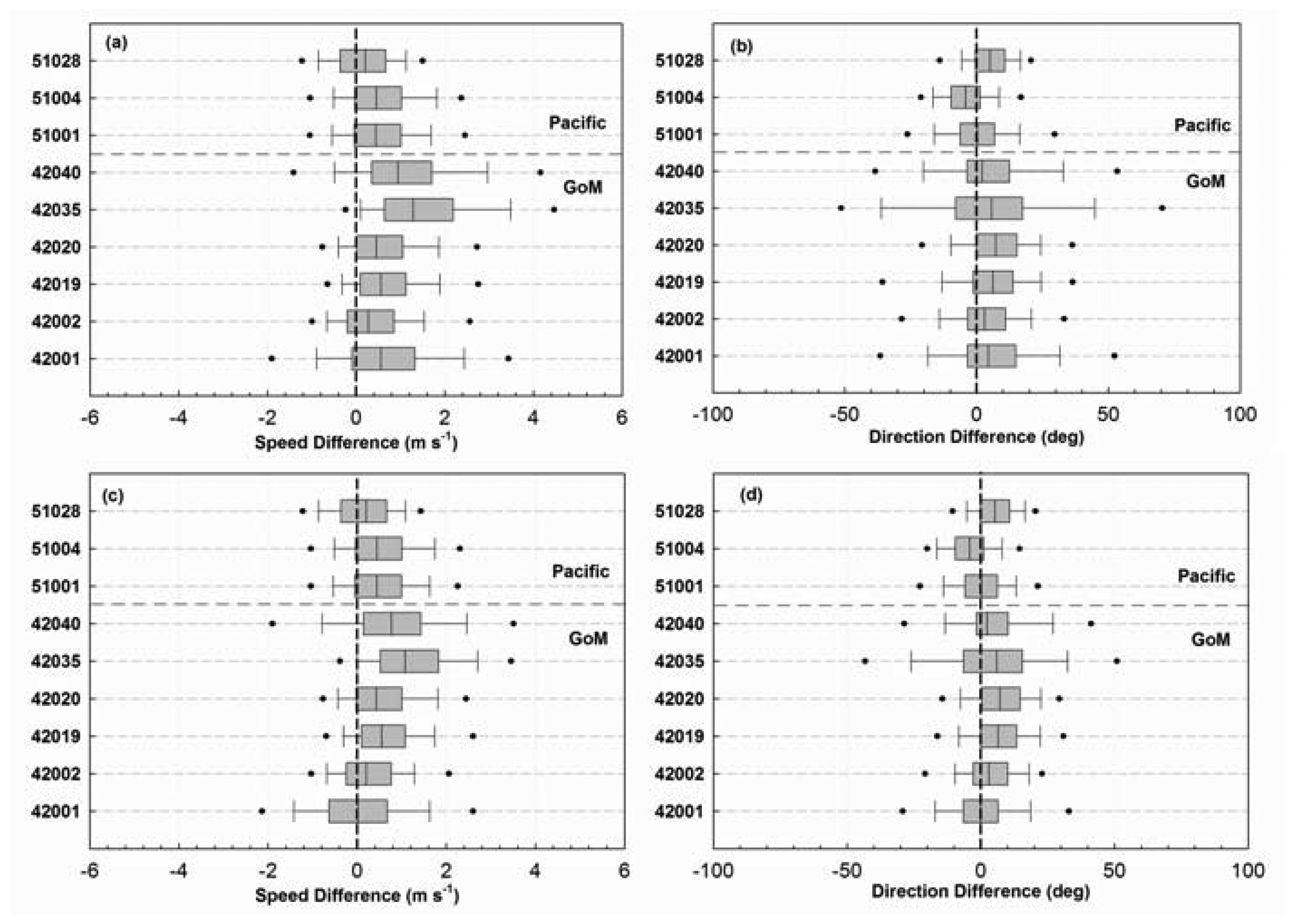
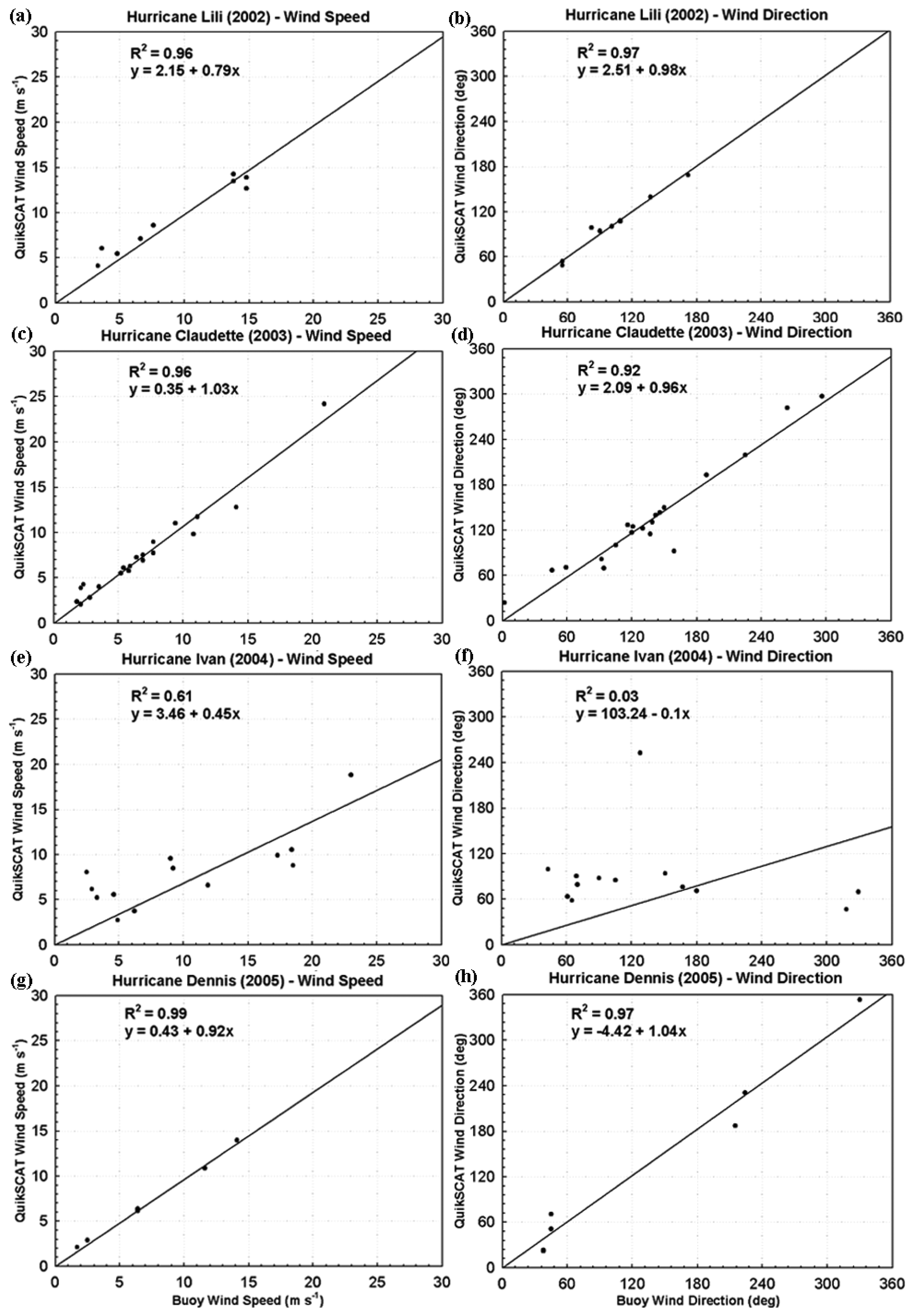
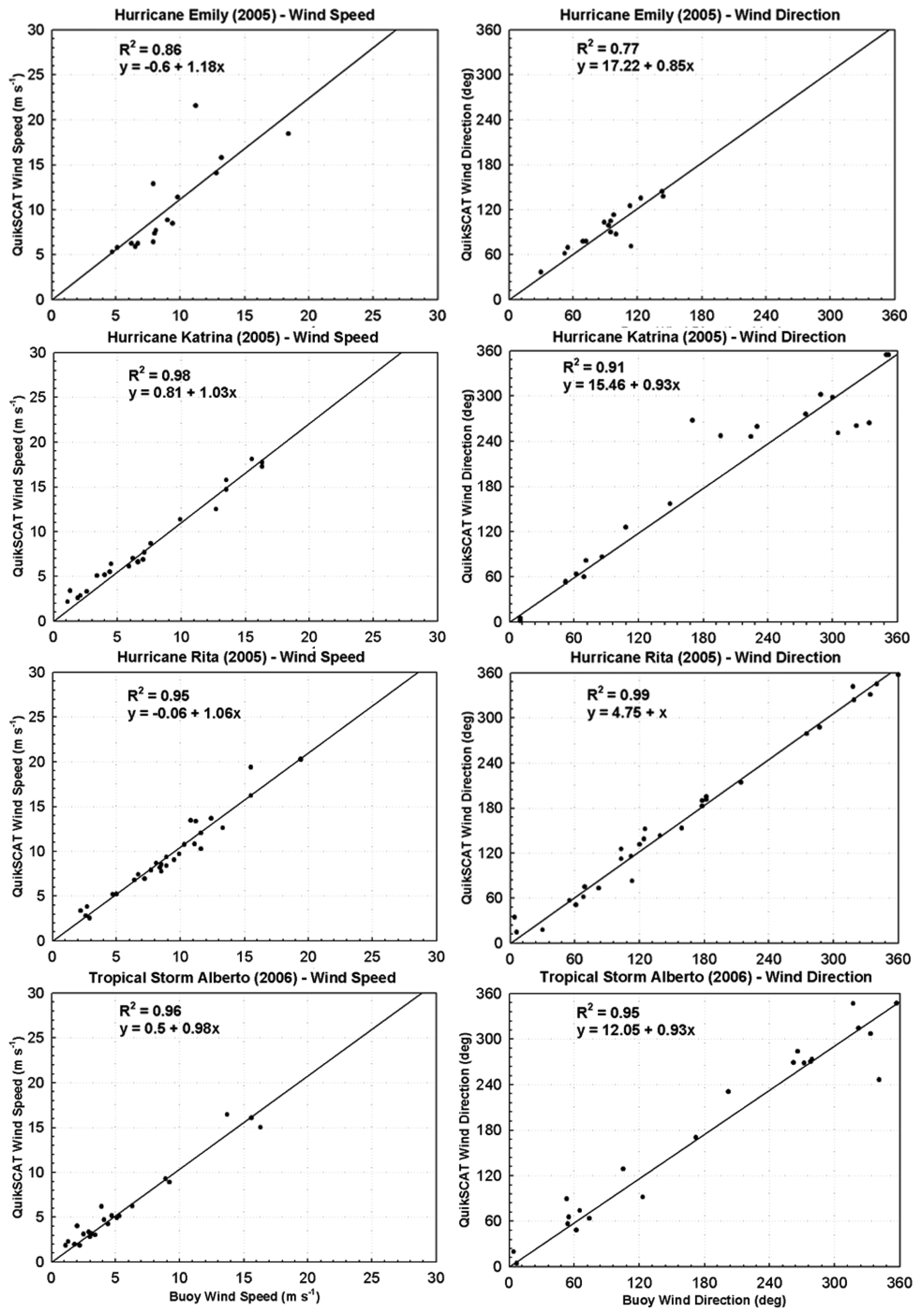
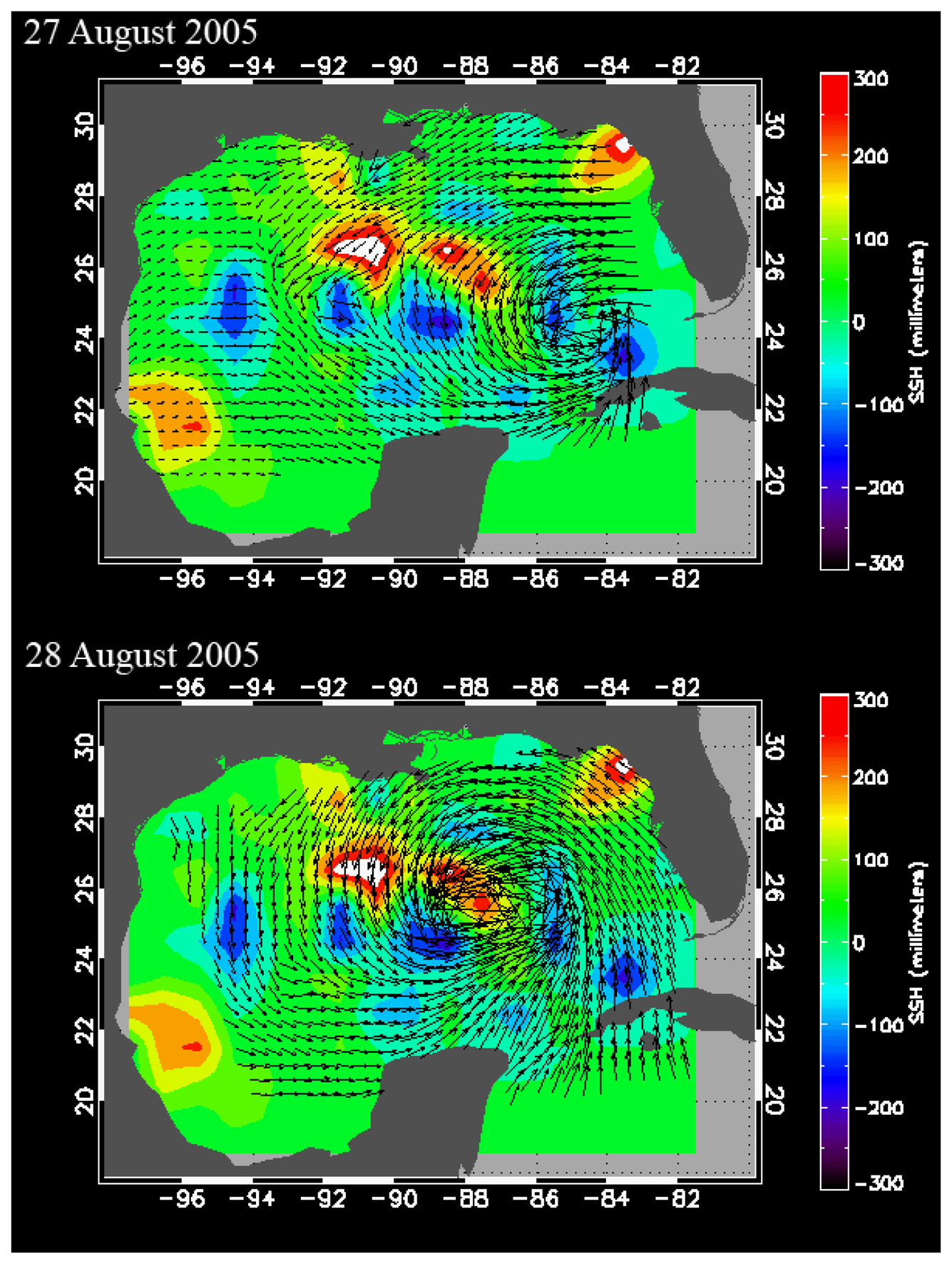
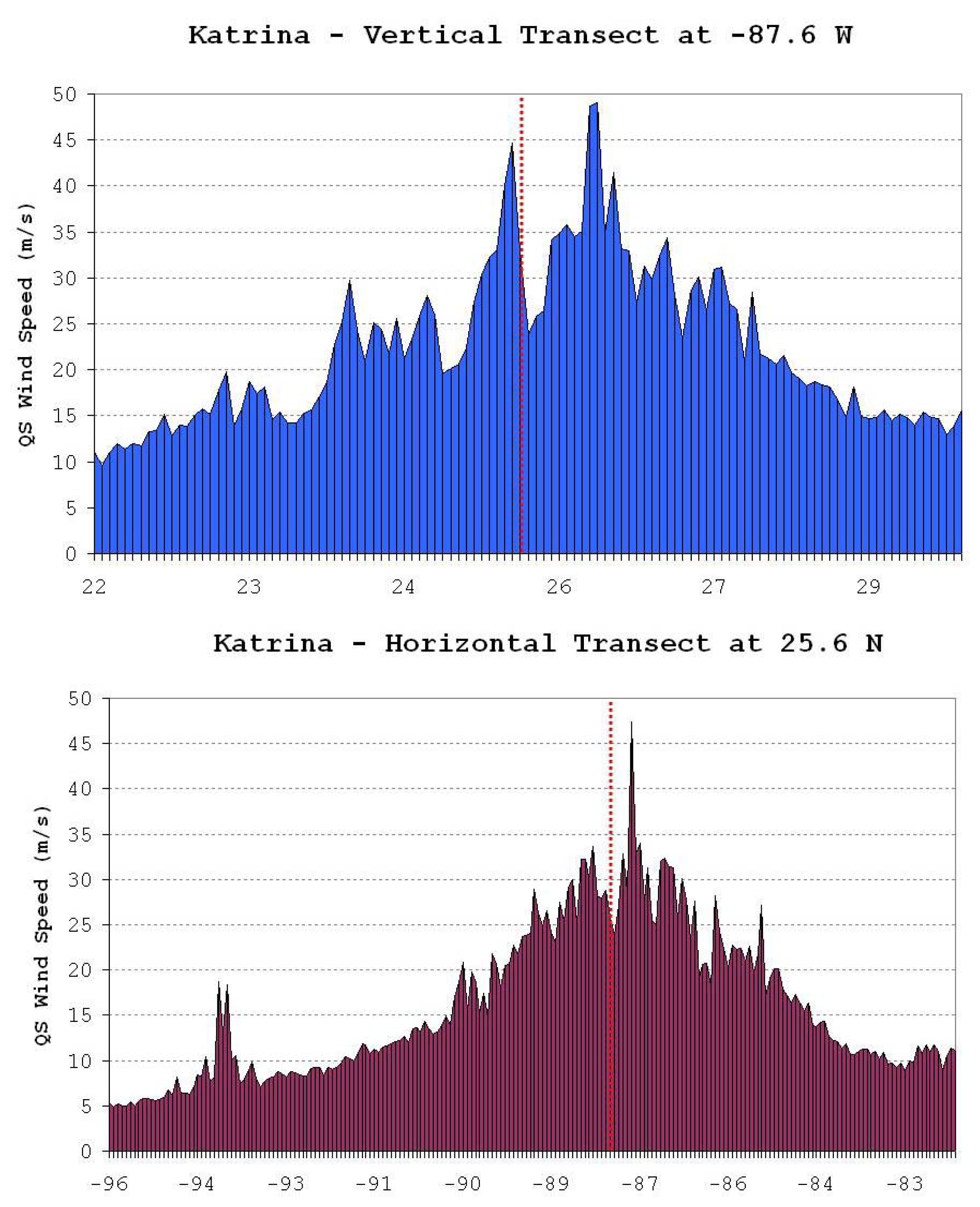
| Buoys | Distance from Coast (km) | Speed (m/s) | Direction (deg.) | Speed difference (m/s) | Direction difference (deg.) | ||||
|---|---|---|---|---|---|---|---|---|---|
| Mean | Std dev | Mean | Std dev | Mean | Std dev | Mean | Std dev | ||
| 42035 | 54.547 | 7.79 | 0.73 | 141.48 | 39.68 | 1.52 | 0.80 | 8.45 | 10.00 |
| 42040 | 87.94 | 7.61 | 1.30 | 155.08 | 52.52 | 0.76 | 0.32 | 3.91 | 7.47 |
| 42020 | 100.19 | 7.44 | 1.10 | 143.39 | 21.64 | 0.47 | 0.22 | 7.89 | 3.42 |
| 42019 | 127.13 | 7.29 | 1.24 | 144.31 | 25.08 | 0.48 | 0.23 | 6.52 | 5.37 |
| 42002 | 293.48 | 7.14 | 1.03 | 130.96 | 20.28 | 0.22 | 0.27 | 2.34 | 6.78 |
| 42001 | 364.88 | 6.98 | 1.29 | 135.91 | 31.51 | 0.008 | 0.34 | -1.76 | 6.31 |
| Dataset | Speed | Direction | ||||||
|---|---|---|---|---|---|---|---|---|
| R2 | RMSE | F-test p-value | t-test p-value | R2 | RMSE | F-test p-value | t-test p-value | |
| QS Level 2B–DIRTH | ||||||||
| All Data | 0.83 | 1.24 | <0.0001 | <0.0001 | 0.86 | 33.77 | 0.6574 | 0.0493 |
| Moderate Winds (3-20 m s-1) | 0.88 | 0.94 | 0.0094 | <0.0001 | 0.93 | 23.31 | 0.7046 | 0.1408 |
| QS Level 2B – NWP | ||||||||
| All Data | 0.79 | 1.55 | 0.0008 | <0.0001 | 0.89 | 30.24 | 0.6840 | 0.0058 |
| Moderate Winds (3-20 m s-1) | 0.79 | 1.37 | <0.0001 | <0.0001 | 0.97 | 14.99 | 0.8860 | 0.0357 |
| QS Level 3 | ||||||||
| All Data | 0.72 | 1.69 | 0.0595 | <0.0001 | 0.82 | 40.52 | 0.5452 | 0.0001 |
| Moderate Winds (3-20 m s-1) | 0.75 | 1.48 | <0.0001 | <0.0001 | 0.89 | 29.53 | 0.7552 | 0.0028 |
| Hurricane | Dates of Occurrence in GOM | Maximum Intensity – NHC | |
|---|---|---|---|
| m s-1 | knots | ||
| Lili | 2-3 October 2002 | 64.3 | 125 |
| Claudette | 12-15 July 2003 | 38.58 | 75 |
| Ivan | 14-15 September 2004 | 72.016 | 140 |
| Dennis | 5-7 July 2005 | 64.3 | 125 |
| Emily | 15-17 July 2005 | 72.016 | 140 |
| Katrina | 26-29 August 2005 | 77.16 | 150 |
| Rita | 20-25 September 2005 | 79.732 | 155 |
| Alberto (tropical storm) | 10-13 June 2006 | 30.864 | 60 |
© 2008 by MDPI Reproduction is permitted for noncommercial purposes.
Share and Cite
Sharma, N.; D’Sa, E. Assessment and Analysis of QuikSCAT Vector Wind Products for the Gulf of Mexico: A Long-Term and Hurricane Analysis. Sensors 2008, 8, 1927-1949. https://doi.org/10.3390/s8031927
Sharma N, D’Sa E. Assessment and Analysis of QuikSCAT Vector Wind Products for the Gulf of Mexico: A Long-Term and Hurricane Analysis. Sensors. 2008; 8(3):1927-1949. https://doi.org/10.3390/s8031927
Chicago/Turabian StyleSharma, Neha, and Eurico D’Sa. 2008. "Assessment and Analysis of QuikSCAT Vector Wind Products for the Gulf of Mexico: A Long-Term and Hurricane Analysis" Sensors 8, no. 3: 1927-1949. https://doi.org/10.3390/s8031927




